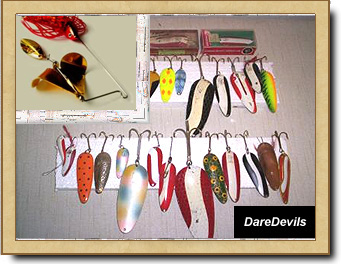Northern Pike Fishing Tips for Eagle Lake:
Northern Pike hit everything and anything. They are the easiest fish to catch. Here are a couple of tips to maximize the amount of strikes and some ideas for really big trophy Pike.
Time of Year: In many Northern Ontario lakes Northern Pike will be shallow in the spring and summer and then start to go deep in mid-August. This is not a big issue on Eagle Lake. Many Pike seem to stay shallow while others follow Walleyes and baitfish down to the edge of drop-offs. In the late summer and fall, either fish 15 feet deep off of shoals and ridges or right up in the really shallow weedy water. Some pike go really deep and you can catch them using Lake Trout techniques.

|
Lures: Traditionally the best lures and probably the most popular lures are the Red-&-White Daredevil and the Yellow 5-of-Diamonds Daredevil. You use the red in clear water and the yellow in murky water. Spinnerbaits, Crankbaits, Bucktails and Williams Weedless Spoons also work well. When using a Daredevil, try casting up high and just before the lure hits the water, jerk it towards you so the lure slaps the surface. This slap sound seems to trigger a better feeding response from bigger Pike.
Pike are also well known for hitting surface lures. Jitterbugs and Spooks are excellent for Pike. A growing trend in Pike fishing, which is getting very popular, is fly-fishing for Pike. With large Pike flies, you can trop the fly in an opening in the middle of thick weeds, which would not be practical for normal lures.
|
Where are the Pike: Pike can be found everywhere. You will find them in the thick weeds or off shoals and even in the streams that run into the lake. Big Trophy Pike generally stay in areas where they can ambush Walleyes, Bass and small Pike.
Below is a list of prime spots for big trophy Northern Pike:
Points leading into weedy bays
Along Wild Rice beds where there are lots of Walleyes
Streams or river mouths
In the thick cabbage weed or other big leaf weeds
Under lily Pads
Narrows between lakes or open water where Walleyes migrate
Drop offs close to thick shallow weeds
Deep Ridges
Shoals or rocky points where the bass and Walleye hang out is a good spot. If the Walleyes or bass stop feeding, it may mean a big Pike has started to feed. This is when you switch to something big and flashy.
